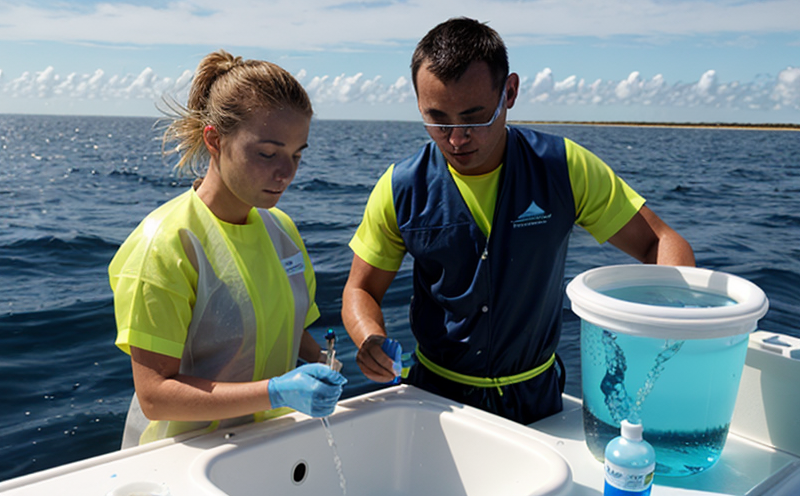EPA 1600 Enterococcus Test in Seawater
The EPA Method 1600 is a standardized protocol developed by the U.S. Environmental Protection Agency (EPA) for detecting fecal contamination in water samples, including seawater. This test specifically targets Enterococcus faecalis and Enterococcus faecium, bacteria that are commonly used as indicators of fecal pollution in aquatic environments.
The significance of this test lies in its role in ensuring public health safety by monitoring water quality. Sewage contamination can lead to the spread of various pathogens, posing risks to human health and marine ecosystems. The EPA 1600 method is widely recognized for its reliability and consistency across different laboratories when properly executed.
The testing process involves collecting a seawater sample, which is then prepared according to specific protocols outlined in the EPA Method 1600. This includes dilution of the sample to ensure it falls within the linear range of the assay, followed by incubation and detection using either conventional agar plate methods or more advanced techniques like quantitative real-time PCR (qPCR).
Results are reported as colony-forming units per milliliter (CFU/mL) when using agar plates. This quantification allows for precise assessment of fecal contamination levels in seawater, which is crucial for regulatory compliance and water quality management.
| Parameter | EPA 1600 Agar Plate Method | qPCR |
|---|---|---|
| Detection Limit | 1,000 CFU/mL for Enterococcus faecalis, Enterococcus faecium | Lower than agar plate method |
| Time to Result | Average 48 hours | 2-3 days including extraction time |
| Variability | Higher variability due to manual handling and incubation conditions | Lower variability, more consistent results |
| Sensitivity | Moderate sensitivity but reliable for regulatory purposes | Highly sensitive for low-level contamination detection |
The EPA 1600 test is essential for compliance with local and international regulations, such as the Marine Strategy Framework Directive (MSFD) in Europe. This method helps ensure that seawater meets stringent quality standards set by regulatory bodies.
- It aids in identifying sources of contamination to implement mitigation strategies.
- It supports water treatment plant operations by providing actionable data on raw water quality.
- It plays a crucial role in environmental monitoring programs aimed at protecting marine ecosystems and human health.
In conclusion, the EPA 1600 Enterococcus test is vital for maintaining the safety and sustainability of our oceans. By accurately detecting fecal contamination, this method ensures that seawater meets stringent quality standards set by regulatory bodies.
Why It Matters
The significance of the EPA 1600 Enterococcus test in seawater cannot be overstated. Fecal pollution in marine environments can lead to severe health risks for both humans and wildlife. Pathogens such as E. coli, which are often associated with fecal matter, can cause gastrointestinal illnesses when ingested.
According to the World Health Organization (WHO), waterborne diseases account for a significant proportion of global disease burden. By using the EPA 1600 method, we can effectively monitor and manage these risks, contributing to public health safety and environmental protection.
The test's role in compliance with international standards is also critical. For instance, the Marine Strategy Framework Directive (MSFD) sets strict targets for reducing pollution from all sources affecting marine water quality. By adhering to EPA 1600 guidelines, countries can demonstrate their commitment to meeting these standards and protecting marine ecosystems.
The test's importance extends beyond regulatory compliance; it also supports sustainable practices in industries such as fishing, aquaculture, and tourism. Ensuring clean seawater reduces the likelihood of outbreaks that could disrupt these sectors. Additionally, the data provided by this testing ensures that water treatment processes are optimized for maximum efficiency.
In summary, the EPA 1600 Enterococcus test is not just a laboratory procedure but a cornerstone in safeguarding public health and marine environments. Its role in detecting fecal contamination makes it indispensable for maintaining the integrity of our oceans.
Why Choose This Test
The EPA 1600 Enterococcus test is an excellent choice for several reasons, making it a preferred method among quality managers, compliance officers, R&D engineers, and procurement professionals. Firstly, its standardized protocol ensures consistent results across different laboratories, which is critical for accurate reporting and reliable data.
- It aligns with international standards such as ISO 16054, ensuring that the test outcomes are recognized globally.
- The method's simplicity allows for efficient implementation in various settings, from small-scale research labs to large industrial facilities.
- Its ability to detect low levels of contamination makes it highly sensitive and suitable for monitoring even the cleanest seawater samples.
Secondly, the test is cost-effective. While some advanced molecular techniques like qPCR may offer higher sensitivity, they can be more expensive to implement. EPA 1600 provides a balance between accuracy and affordability, making it an attractive option for budget-conscious organizations.
Thirdly, the test supports comprehensive compliance with regulations such as the Marine Strategy Framework Directive (MSFD) in Europe and similar initiatives worldwide. This ensures that water quality management efforts are aligned with international best practices.
Furthermore, the EPA 1600 Enterococcus test fosters a culture of continuous improvement by providing actionable data on water quality. This enables organizations to identify areas for enhancement and implement targeted interventions to improve performance.
In summary, choosing the EPA 1600 Enterococcus test offers numerous benefits, making it an ideal choice for those committed to maintaining high standards of water quality and environmental protection.





